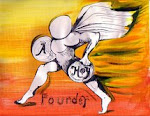Brazil behaves as if dictatorship never happened. It's amazing!
We deal with torture in mental institution so it is not that off-topic. This is political torture and they are, or should be, brought to society when the dictatorship is over.
Dictatorship should be eradicated from the world. It is unacceptable.
p251
p252
The article is here."Torture is institutionalized under regimes like these, a deliberate political and social policy, a calculated strategy of widespread intimidation which goes far beyond the old abuses of police interrogation. The secret character of torture is only ambiguously maintained: protests against it in the congress or the press are rare and swiftly punished, but when suspects are arrested it is routine to beat them in the sight and hearing of their neighbors. The population at large must know something of disappearance, enough to be afraid: the opposition must know more, enough to despair. There are circles of awareness, but within the System itself, there is hardly any pretense: the Report of the Archdiocese, compiled from the official records of the military courts themselves, gives a frank and open picture. Once in the custody of OBAN or DOI-CODI, very few escaped torture; but most victims did not refer to it when they finally reached the courtroom, silenced by their own fear or a well-grounded sense of futility as well as the advice of council. Nevertheless, of the seven thousand defendants tried in this period, nearly two thousand had the temerity to speak out in such a court, testifying that they had been tortured and protesting against it. Although their courage had no effect and allegations of torture were ignored and dismissed, the information they provided, information the military regime did not even think to suppress, is invaluable and gives us an understanding of the process.
Torture had a budget and staff, training procedure, study and teaching methods, was regarded as a science. There are classes, classrooms, visual aids, technical terms, and apparatus: slide photographs of torture are followed with practical demonstrations on prisoners. The classes are described in the testimony of the prisoners who were used as live subjects in classes where acknowledged experts like Lieutenant Hayton would instruct large groups of eighty or one hundred army personnel, the lecture and photographs followed with practical "hands-on" exercises. Dulce Pandolfi, a twenty-four-year-old university student, was used as a guinea pig for torture classes in the barracks on Barao de Mesquita Street in Rio: "stripped naked and subjected to beatings and electric shocks and other torments such as the 'parrot's perch.' After being taken to her cell, the defendant was assisted by a doctor*, and after a while, was again tortured with exquisite cruelty in a demonstration of how torture should be carried out." One student prisoner was even used as a subject before an audience of military cadets at a preparatory school. Another prisoner was told as he was being used for demonstration that his torturers were exporting their sophisticated knowledge of the technology of pain and "owed nothing to any foreign organization" in their expertise.
Perhaps they overstated their case: the practice of using live subjects, according to the Report of the Archdiocese [Brazil], was introduced by the American police instructor Dan Mitrione in the early years of the regime: "Mitrione took beggars off the streets and tortured them in classrooms, so that the local police would learn the various ways of creating, in the prisoner, the supreme contradiction between the body and the mind by striking blows to vulnerable points of the body." When Mitrione was transferred to Uruguay to teach policemen there, the use of live subjects could be refined upon.
The methods of torture reported in the military court records are now common throughout the continent. They have names like the "parrot's perch" and the "ice box" and the "dragon chair." In the first, the prisoner's wrists and ankles are tied to an iron bar anchored between two tables, suspended just above the ground. The body is then beaten or shocked with electricity. The dragon chair is a device into which one is strapped for the same purpose. It has a metal seat to increase conduction and an iron bar that pushes the legs backward with each shock, causing deep gashes. Electric shock is produced by army field telephones and various rotary devices called "the little pepper" or "the doubler of tension." Ice boxes are any number of cold and restrictive spaces where the victim is confined for long periods to endure deafening noises, strong light, or lack of ventilation. Insects and animals are also used: snakes, dogs, cockroaches. Every sexual orifice and organ is invaded through these methods: electric shock is typically directed at the most vulnerable parts of the body-the fingers and mouth, as well as the penis, vagina, breasts, and anus. The experience of drowning is created in many ways as water is forced into the mouth through tubes or towels; strangulation is approached by hanging or with a garotte. Victims are made to stand precariously on aluminum cans, or hung on beams as if crucified.
Torture is routinely practiced for a considerable period ever before interrogation begins, for its own sake and without the excuse of obtaining information, to induce terror and despair and to bring about the victim's moral destruction. To complement this, friends and relatives are captured so that emotional ties may be called upon. From the records of the court it is clear that "children were sacrificed before their parents' eyes, pregnant women had miscarriages and wives were subjected to suffering to make them incriminate their husbands." Women prisoners were raped, penetrated with objects, and ritually humiliated by groups of males before whom their vulnerability I was ingeniously exploited.
p251
In Brazil ... the Amnesty of 1979 closed all cases of the regime's crimes against its citizens, and the long list of the 440 torturers printed at the end of the Archdiocese Report-names obtained through the military court's own records of its procedures against their victims-is a list of men now beyond the reach of the law, which includes many still "in service" to the republic.
Force remains immune to justice, even the "moral justice", the Report argues for, having despaired of any other and anxious not to be accused of "revenge." If the rule of law and democracy has returned to Argentina and Brazil, it may be only temporarily; meanwhile it has been extinguished elsewhere.
p252
Somehow the official version is always a lie, and even the most informative reports fail to produce results. Because if a trial ever takes place, the court fails to convict: the witnesses come forward, the bodies are exhumed and analyzed for evidence of torture by experts, yet somehow the military always escapes unscathed. Somehow the national security state maintains its immunity; it is such a general phenomenon now, such a widespread ideology, so essential to the military element and its unchallenged power in the society of the region and its neocolonial mission, that, like a colony of bacteria temporarily in remission, it simply relocates and continues to operate with impunity.
p259
* DOCTOR? I did read it right.
















No comments:
Post a Comment